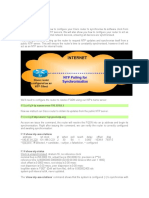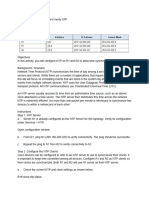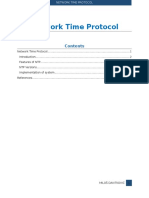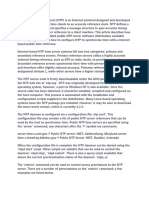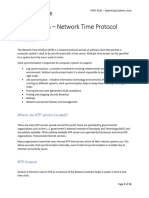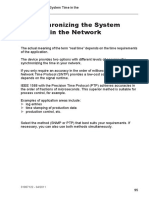Network Time Protocol (NTP)
Uploaded by
Babu Srinivasa KumarNetwork Time Protocol (NTP)
Uploaded by
Babu Srinivasa KumarNTP
Key Commands
Ntp master 2 <- makes it a master with stratum 2 Clock calendar-valid Clock timezone EST -4 Client: Ntp update-calendar Ntp server 10.1.1.1 Clock timezone EST -5 Clock summer-time PDT recurring Authentication (in global): Ntp authenticate Ntp authentication-key 1 md5 MyKey Ntp trusted-key 1
Shows and Debugs
Show Show Show Show calendar clock [detail] net associations ntp status
Additional Commands
In broadcast mode (global configs) Ntp broadcast version 1 <- sends out ntp broadcasts Ntp broadcast client Ntp broadcastdelay miliseconds <- setup Access restriction Ntp access-group [query-only|serve-only|serve|peer] access-list-number ntp source loop 0 <- uses l0's ip address as source interface ethernet 0 ntp disable <- to disable on that specific int. ntp update-calendar <- ntp updates rtr's calendar For Banyan VINES (in global) Vines time use-system <- distributes clock to other VINES systems Vines time set-system <- receives VINES time svcs
clock timezone zone hours clock summer-time .. sets Daylight savings params. Clock read-calendar <- set clock from calendar
Spot The Issue
When multiple clock sources are available (VINES, Manual Configs, etc), NTP will be considered as more authoritative. A machine will never synchronize to an NTP server if the server is not synchronized itself. Synchronization can take up to 30 minutes since IOS is looking for a stable source, and will not update until it is satisfied.
Notes
You might also like
- NTP (Network Time Protocol) and PTP (Precision Time Protocol)No ratings yetNTP (Network Time Protocol) and PTP (Precision Time Protocol)7 pages
- 10.3.4 - Packet Tracer - Configure and Verify NTPNo ratings yet10.3.4 - Packet Tracer - Configure and Verify NTP2 pages
- TF1.7 How To Guides - Synchronise Computer Time With TFish.v1.0No ratings yetTF1.7 How To Guides - Synchronise Computer Time With TFish.v1.05 pages
- 15.2.1 Packet Tracer - Configure and Verify NTP - ILMNo ratings yet15.2.1 Packet Tracer - Configure and Verify NTP - ILM2 pages
- Configuring NTP: Understanding How NTP WorksNo ratings yetConfiguring NTP: Understanding How NTP Works8 pages
- 15.2.1 Packet Tracer - Configure and Verify NTPNo ratings yet15.2.1 Packet Tracer - Configure and Verify NTP2 pages
- Network Time Protocol Best Practices White PaperNo ratings yetNetwork Time Protocol Best Practices White Paper26 pages
- Configuring Apple Macintoshes To Use NIST Time Servers: Section 1: PurposeNo ratings yetConfiguring Apple Macintoshes To Use NIST Time Servers: Section 1: Purpose11 pages
- Network Time Protocol (NTP) Server: 07 April 2016No ratings yetNetwork Time Protocol (NTP) Server: 07 April 20169 pages
- 6.6.4 Packet Tracer - Configure and Verify NTP (U2000745)No ratings yet6.6.4 Packet Tracer - Configure and Verify NTP (U2000745)2 pages
- Microsoft PowerPoint - 8 12 NTP and CRON LabNo ratings yetMicrosoft PowerPoint - 8 12 NTP and CRON Lab56 pages
- DCN-Network Time Management ConfigurationNo ratings yetDCN-Network Time Management Configuration10 pages
- Data Sheet - Digital NTP PoE Clocks-GTD368 Series 2023.7.6No ratings yetData Sheet - Digital NTP PoE Clocks-GTD368 Series 2023.7.65 pages
- The Internet Network Time Protocoal Mills-NtpNo ratings yetThe Internet Network Time Protocoal Mills-Ntp12 pages
- Internal Network Time Protocol Server: Timing and Frequency ProductsNo ratings yetInternal Network Time Protocol Server: Timing and Frequency Products1 page
- Com 319 Report An Explanation of The Network Time Protocol AbstractNo ratings yetCom 319 Report An Explanation of The Network Time Protocol Abstract7 pages
- Chapter 21 - Clock Synchronization in Distributed Systems Using NTP and PTPNo ratings yetChapter 21 - Clock Synchronization in Distributed Systems Using NTP and PTP73 pages
- Network Time Protocol (NTP) General Overview: David L. Mills University of DelawareNo ratings yetNetwork Time Protocol (NTP) General Overview: David L. Mills University of Delaware22 pages
- Network Time Protocol (NTP) General Overview: David L. Mills University of Delaware Mailto:mills@udel - EduNo ratings yetNetwork Time Protocol (NTP) General Overview: David L. Mills University of Delaware Mailto:mills@udel - Edu22 pages
- Network Time Protocol (NTP) General Overview: David L. Mills University of Delaware Mailto:mills@udel - EduNo ratings yetNetwork Time Protocol (NTP) General Overview: David L. Mills University of Delaware Mailto:mills@udel - Edu22 pages
- Slidex - Tips - 7 Synchronizing The System Time in The Network PDFNo ratings yetSlidex - Tips - 7 Synchronizing The System Time in The Network PDF12 pages
- 10.3.4-Packet-Tracer - Configure-And-Verify-NtpNo ratings yet10.3.4-Packet-Tracer - Configure-And-Verify-Ntp2 pages
- Network with Practical Labs Configuration: Step by Step configuration of Router and Switch configurationFrom EverandNetwork with Practical Labs Configuration: Step by Step configuration of Router and Switch configurationNo ratings yet





